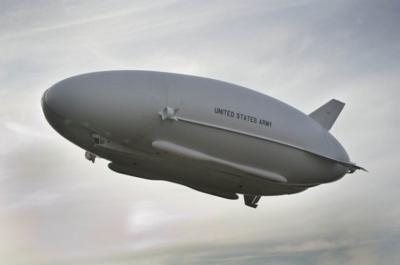Fri, Aug 10, 2012
Medium-Altitude-Long-Endurance Lighter-Than-Air Aircraft Can Operate Manned Or Unmanned
In its first flight, the Army's hybrid air vehicle known as the Long Endurance Multi-Intelligence Vehicle, or LEMV, stayed aloft over Joint Base McGuire-Dix-Lakehurst, NJ, for more than 90 minutes on August 7. The LEMV, like a blimp, is capable of carrying multiple intelligence, surveillance and reconnaissance payloads for more than 21 days at altitudes greater than 22,000 feet. The U.S. Army Space and Missile Defense Command/Army Forces Strategic Command conducted the first flight test of vehicle.

"Murphy Bays" on the LEMV can carry just about any kind of sensor or equipment, and design specifications for the LEMV require the vehicle to provide up to 16 kilowatts of electrical power for those payloads. The LEMV is intended to be used to conduct long-term Intelligence, Surveillance, and Reconnaissance, or ISR, and persistent stare-type missions, and can also be used as a communications relay.
The primary objective of the first flight was to perform a safe launch and recovery of the LEMV. A secondary goal was to verify the flight control system operation. Additional objectives included airworthiness testing and demonstration, as well as system-level performance verification. All objectives were met during the first flight.
The football field-sized LEMV can operate at altitudes greater than 22,000 feet above mean sea level, has a 2,000 mile radius of action, can carry a 2,750 pound ISR payload for more than 21 days, and boasts a fuel consumption that is more than 10 times less than comparable capabilities. Design requirements for the LEMV include providing up to 16 kilowatts of electrical power for payload, as well as runway independence.
The LEMV is designed to be a recoverable and reusable multi-mission platform. It can be forward located to support extended geostationary operations from austere locations and capable of beyond-line-of-sight command and control. During this first flight, the LEMV was manned, though the air vehicle can also operate unmanned.
Following a planned and detailed inspection of the vehicle, there will be additional manned flights.
(Image provided by the U.S. Army)
More News
Aviation Governance Secured...At Least For a While The National Business Aviation Association similarly applauded the passage of the FAA's recent reauthorization, contentedly recou>[...]
Emphasis On Growing The Future of Aviation Through Concentration on 'AFFORDABLE FLYERS' It's been a number of years since the Latest Edition of Jim Campbell's HUGE SportPlane Resou>[...]
Amazilia Aerospace GmbH, Develops Digital Flight Control, Flight Guidance And Vehicle Management Systems Textron eAviation has acquired substantially all the assets of Amazilia Aer>[...]
Honeywell's Primus Brings New Tools and Niceties for Hawker Operators Hawker 4000 business jet operators have a new installation on the table, now that the FAA has granted an STC f>[...]
Company Celebrates Niche-but-Important Advancement in Industry Standards Echodyne has announced full integration of its proprietary 'EchoFlight' radar into the e American Aerospace>[...]
 Bolen Gives Congress a Rare Thumbs-Up
Bolen Gives Congress a Rare Thumbs-Up The SportPlane Resource Guide RETURNS!!!!
The SportPlane Resource Guide RETURNS!!!! Buying Sprees Continue: Textron eAviation Takes On Amazilia Aerospace
Buying Sprees Continue: Textron eAviation Takes On Amazilia Aerospace Hawker 4000 Bizjets Gain Nav System, Data Link STC
Hawker 4000 Bizjets Gain Nav System, Data Link STC Echodyne Gets BVLOS Waiver for AiRanger Aircraft
Echodyne Gets BVLOS Waiver for AiRanger Aircraft



